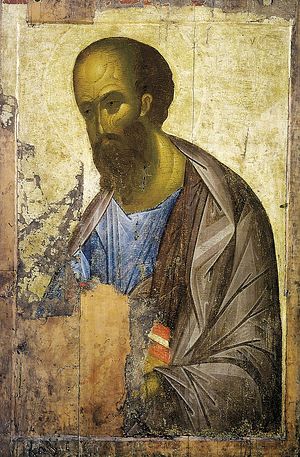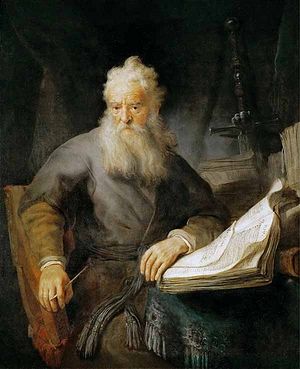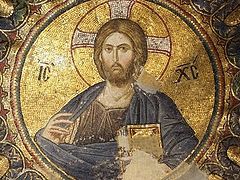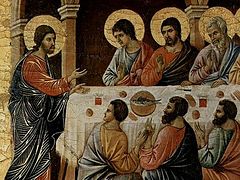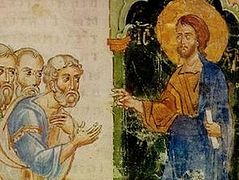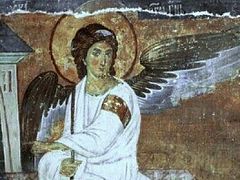See Christ is Risen! Part 5a. Tradition
We continue with Dr. Jeannie’s lesson 5 on the Resurrection, in which she discusses the apostle Paul and his first epistle to the Corinthians.
An early Creed.
Let’s see what Paul said; he received this and passed on to them. The way he phrases it sounds very much like an early Creed. And I think we can say almost without qualification that this was an early Christian Creed. They did have Creeds, they did have hymns, they did learn things by memorization. This is something that everyone was taught and everyone knew; and here’s why it sounds like a Creed. He begins by saying, “Here is what I delivered to you, what I also received, that Christ died for our sins, that He was buried, that He rose on the third day, that He appeared to this person and this group.” The way he marks it off, “this, this, this,” shows that it is really a creedal formula. So, it’s a very early Christian Creed.
What is this little Creed? It’s a Creed, but it’s very narrow—it’s only about the Resurrection appearances of Christ. So what are they? What is it that he passed on to them? First, he says that Christ died for our sins “according to the Scriptures.” Now Chrysostom notes how interesting it is that St. Paul begins by affirming that Christ actually died, that He was human, that He had a body that was His own. This is very important, and we’re going to have to address this also later in our discussion on the Resurrection. In his own particular context, Chrysostom was responding to certain heresies that denied the humanity of Christ, believe it or not. We can’t imagine a heresy today that denies the humanity of Christ, but there were such things that were very, very strong during the period of the first few centuries of Christianity. But I think that being reminded that Christ died is very important for our purposes too, because here we’re talking about a physical Resurrection, so we have to begin with the fact that Christ had a body and that He actually died. This is verse 3: “That Christ died for our sins according to the Scriptures, and that He was buried, and that He rose again the third day according to the Scriptures.” So, of course, it talks about how He was buried. Why? Because the empty tomb is part of the Tradition. He rose on the third day—there is that “third day” language. Do you see how prevalent it was in the Early Church? It was prevalent because Christ foretold that He would rise on the third day. There is a great deal of meaning behind the fact that He rose on the third day; then, in verse 4, this is the second time that St. Paul mentions “according to the Scriptures”—that Christ died for our sins “according to the Scriptures.” He was buried, He rose on the third day “according to the Scriptures”. What is this language, “according to the Scriptures”? Which Scriptures? What is He talking about? He’s not talking about the New Testament. When we think of “the Scriptures” that talk about Christ rising on the third day, we’re thinking of the Gospels, right? (Now maybe you’ll also think of 1 Corinthians 15, but that’s not what he’s talking about, because the Gospels did not exist at the time Paul wrote this.)
So which “Scriptures” are they? They are the Jewish Scriptures. You see, the only “Scriptures” in the Early Church were the Jewish Scriptures; there was no such thing as the “New Testament.” This is something that is pretty hard to imagine for us and shows how little we know about the Old Testament, that their only Scriptures were the Old Testament Scriptures. This is very important because for those of you who come from a tradition of “Sola Scriptura.” You have to ask yourself: what did the Early Christians do without the New Testament? How can we say, “Rely on the Scriptures alone” (that’s the meaning of the words “Sola Scriptura” for the rest of you who aren’t aware of it.) What did they do before there was a New Testament? Because even after the books of the New Testament were written, like St. Paul’s epistles or the Gospels, first of all, not everyone did had a copy of every book. The people in Corinth had the epistles that Paul wrote to Corinth. They didn’t have the epistles to the Thessalonians, to the Ephesians and to the Colossians and everything else. They only had the epistles that Paul sent them. Is was the same for the Thessalonians. They had the two epistles that Paul sent them. They didn’t have all of the letters of Paul, at least not in the beginning. It is the same with the Gospels, when they were written. Luke was probably in Greece, and his Gospel was read in Greece. They didn’t have Matthew’s Gospel and Mark’s and John’s. They didn’t have them. And even when they had them, those books were not considered Scripture right away. This is something we’re going to be talking about in our Introduction to the Bible.
Oral Tradition was the only reliable source
So in the beginning, the Early Church did not even have apostolic writings, and then when they did, those writings were not considered “Scripture” immediately. It took a very long time before the Church recognized the inspiration of the writings and considered them Scripture. I’ll show you later how we know this. The point is: What did the Early Church rely on for those of you who want to go back to the Early Church and model yourselves after the Early Church? What did they rely on? Oral Tradition. Exactly the thing St. Paul is referring to here, the oral Tradition, the Apostolic Witness about the Resurrection of Christ. That’s all they had: apostolic teaching that was passed along only orally at this point. So that’s what he means by “according to the Scriptures”—the Jewish Scriptures. It means, “in fulfilment of prophecy.” So Christ died for our sins “in fulfilment of prophecy.” He rose on the third day “according to the Scriptures,” that is, “in fulfilment of prophecy.” So to whom did He appear first? I’m reminding you, brothers and sisters of Corinth, what I first taught you, “that Christ died, that He was buried, that He rose again in fulfilment of prophecy, that He was seen by Cephas and then by the Twelve.” This is verse 5. Who was Cephas? Well that’s Paul’s way of referring to Peter. In Greek we would say Kephas. The name Peter in Hebrew is Cephas. Peter is “Petros” in Greek.
So the first person Paul mentions that Christ appeared to is Peter. Now, that’s not in any of the Gospels, except that it is hinted at in the Gospel of Luke, if you remember what I told you about the appearance to the two disciples on the road to Emmaus. Remember when the Lord appeared to them on the road to Emmaus and they saw Him in the breaking of the bread? They immediately turned around, went to Jerusalem, found the Twelve, and said, “The Lord has risen! He’s appeared to us!” The Twelve said, “We know He’s risen! He has appeared to Simon.” So Luke knows about this appearance to Peter, but he doesn’t describe it. Then while they’re standing there, the Lord appears to them. So Luke knows about this appearance to Peter but he doesn’t tell it, and no other Gospel tells it, but Paul knows about it, and there it is: he’s the first one who is mentioned. “He was seen by Cephas, and then by the Twelve.”
500 brethren saw Christ.
Note what I told you, that the twelve disciples are not called, “the disciples.” They’re not called “the apostles.” They’re called “The Twelve.” This is told to us in Luke and it’s also told to us in John, but Paul doesn’t mention about whether Thomas was present or anything like that. But we know that the Lord appeared to them, and at this point there are eleven of them because Judas is not with them, but they’re still called “The Twelve.” That’s the name of the group. In verse 6, Paul tells us that after that, He was seen “by over 500 brethren at once, of whom the greater part remain to the present, but some have fallen asleep.” This is the most tantalizing reference of all. The Lord appeared, in the body, the Resurrected body, to 500 brethren, 500 believers, all at one time. Unfortunately we don’t know anything else about this appearance. Isn’t that amazing? I think it’s amazing, because Paul repeats it to them as if everyone knew about it! But this particular story is not recorded in the Gospels. Maybe it was not recorded because everyone knew it, and it never occurred to them that the memory of this or the knowledge of this story would be lost since no one wrote it down. But that’s the situation here. Isn’t it amazing? I wish we knew something about this story. I’m just so intrigued by it. Where was this? Where did this take place that He appeared to 500 brethren at once? What did He say to them? How did He look? I mean, did they recognize Him right away? I wish we knew. We just don’t know enough about this Resurrection appearance, but it was so famous in the early Church that it was part of this early Creed that everyone knew about. It’s amazing that we have lost the knowledge about this. It would be exciting if there were to be a discovery of some early document that talks about this, but so far there’s nothing that we know of. Now what does he say about these 500? He tells us that “the greater part,” that is, most of them, “remain,” that means they’re alive, “to the present day,”—twenty years or so from the time of Paul’s writing. They’re still alive, most of them, but “a few of them have fallen asleep”—that’s s way of referring to death. Some have “fallen asleep.” That doesn’t mean that they’re sleeping or in a coma. It means that they have died. That’s the Christian way of referring to death because that’s the way the Lord referred to death. He said: “Our brother Lazarus is sleeping,” and He meant of course that Lazarus had died. The Orthodox tradition is to say, when someone has died, that he or she has “fallen asleep in the Lord.” That’s the proper way to refer to it. By the way, dear brothers and sisters, we have to remember and keep these traditions. We shouldn’t say “passed away” or “passed.” We should say, “so and so has fallen asleep in the Lord.” That’s the way to refer to death.
So, He was seen by all of these people, most of whom are still alive. Now, why is Paul telling them that most of them are still alive? To remind them that if you want to check it out for yourself and find someone who’s an eyewitness to this event, there are plenty of them around, you can find out who really saw the Lord alive again in the body among these 500.
Verse 7 says, “After that, He was seen by James”. This is probably—it doesn’t say, but it was probably—James, “the brother of the Lord,” the head of the Church of Jerusalem. He was not one of the Twelve, but he was an apostle, because of course he was an eyewitness to the Resurrection. He was considered an extremely holy man, very highly regarded in the early Church, and as I said, head of the Church of Jerusalem. He was seen by James. This appearance is also not recorded in the Gospels. So you see, none of the Gospels have everything. And then it says, “finally by all of the apostles.” Now there you again see that an “apostle” is not synonymous with “the Twelve,” because the Twelve have already been mentioned. “All the apostles.” How many were there? I don’t know. Were there more than the 500 or are there fewer than the 500? It’s not clear, but there were lots of apostles. As I said, there were many, many people, as you can see, who were eyewitnesses to the Resurrection of Christ.
One born out of due time.
In the next verse, “then, last of all He was seen by me also as by one born out of due time.” So, at the very last, Paul mentions himself. When he says, “This is the gospel which I preached to you,” I’m sure he was giving them his testimony about meeting the risen Christ on the road to Damascus, but I don’t think that Paul’s experience was part of this early Creed, which was very well known in the early Church. Although everyone knew Paul and everyone knew his story, he tells his story in his own epistles, but his story is also told three times in the book of Acts. It was a rather famous story; and yet why does Paul include it here, if I’m correct that it was not part of this Creed? When people in other places, people who were not taught by Paul, learned about the Resurrection of Christ, that He died on the Cross and was buried and rose on the third day, that all of this was fulfilment of prophecy, and that He appeared to Cephas and the Twelve then the 500, then James and all of the apostles, I think it stopped there. I don’t think, generally speaking, that they learned that He was seen by Paul. Why is that? Because this appearance of the risen Lord was really not an appearance. He doesn’t see the Lord. There was a bright light. He hears a voice. It was very real to Paul. There’s no question that it was an appearance in that sense, and that it changed Paul’s life very dramatically, but it’s not the same kind of appearance as the others—because the other appearances were in the flesh and they were in the period between the Resurrection and the Ascension. And there was a difference in the quality and the timing of those appearances.
Paul’s appearance of the Risen Lord is, of course, after Pentecost; he meets Him on the road and he hears the voice, etc. But Paul includes his testimony here. Why is that? Because he wants to be regarded as an apostle. The fact is that in the early Church most people did not consider Paul an apostle, and that’s pretty shocking to us, because He’s considered today generally to be the greatest of the apostles. As a matter of fact, I think that Paul in the end had the “last laugh” if you will, because in the Orthodox tradition, when the Fathers of the Church are talking about the apostles and say only “the Apostle” before they want to quote something, such as, “as the Apostle says”, it’s always St. Paul—unless they’re quoting, for example, from the Gospel of John and they say “the apostle.” But if they’re just giving a sermon and quoting a random verse of Scripture and they refer to “the Apostle,” it’s Paul. It’s funny, because he’s the one who was not considered an apostle by the early Church. But in the end, today, and even long before today, he was “the Apostle.” Isn’t that wonderful?
He was lastly seen by Paul “as one born out of due time.” What does that mean? Because St. Paul was not among The Twelve, he was not among The Seventy. He was not one of the Apostles. He was not accepted as an apostle by most of the Christians; except, of course, by those for whom he was a spiritual Father. Certainly the communities he founded respected him as an apostle, but he had to fight to be regarded as an apostle, because he was not part of the earthly ministry of Christ. He did not follow Jesus during His earthly ministry, He was not an eyewitness to the Resurrection the way the others were, which is what made one an apostle.
The Least of the Apostles
He insists that he’s an apostle, because he says, “I met the risen Lord on the road to Damascus.” He is an apostle because had this experience, and also because the word “apostle” means “one who is sent.” Paul says, “I was sent. I was sent by Christ Himself to preach.” He considers himself an apostle, and that’s why he usually includes that title after his name in his Epistles: “From Paul, an apostle of Christ Jesus,” etc. “to the Churches of Galatia,” etc. He knows, however, that he is “the least of the apostles”; and I don’t think he’s saying this out of any kind of false modesty. He says in verse 9, “For I am the least of the apostles, who am not worthy to be called an apostle because I persecuted the Church of God.” This never left him. I think that Paul always felt very badly about this, and tried very hard to overcome the fact that he had persecuted the Church, by working much harder than the others. He actually says in verse 10, “But by the grace of God I am what I am,” “His grace toward me was not in vain.” That is, it wasn’t useless, wasn’t pointless. He showed grace toward Paul, and look at what Paul has done with the grace that God has shown him; look at the communities he established, look at the souls that he brought to Christ etc. “But by the grace of God, I am what I am and His grace toward me was not in vain, but I labored more abundantly than they all. Yet not I, but the grace of God which was with me.” So he’s saying here that he’s an apostle because he worked harder than anyone else. Well, wait a minute: he doesn’t want to take all the credit for it. It was not him, but the grace of God, which was with him. So there you see, dear brothers and sisters, the same argument that he made later in 2 Corinthians when he is forced to defend his status as an apostle. This is what he says. He says, “I worked harder than anyone else,” and this is one of the reasons why he feels he has the right to be considered an apostle. And the last verse in this little pericope: “Therefore, whether it was I or they, so we preach and so you believed.” So he’s saying here, whether you accept their testimony as genuine apostles—no one questions that they are the apostles—or whether it was I from whom you received this testimony, we preach the same thing, we’re on the same page. My apostolic testimony is exactly the same as that of the other apostles. This “so we preach”, not “preached”, but “preach”, meaning, “we continue to preach,” is in the present tense: “We preach the Resurrection of Christ, and so you believed.”
Well, this lesson has gone on too long and I need to stop at this point, but we will continue with chapter 15 of 1 Corinthians. I encourage you to read ahead and see what it says, because the Apostle is going to explain the Resurrection. Now that he has reminded them of what he taught them, he doesn’t stop there; he goes on to explain to them the meaning of the Resurrection, why it is important, and so on. He spends all of chapter 15 talking about the Resurrection. It is extremely important theologically, so we will continue our discussion of St. Paul, 1 Corinthians 15 next time. In the meantime, let’s say our prayer, and let us continue to say it and mean it from the depths of our hearts: Christ is risen from the dead, trampling down death by death, and upon those in the tombs bestowing life. Alithos Anesti o Kyrios. Truly the Lord is Risen.
Presbytera and Dr. Jeannie Constantinou’s podcasts can be found here.

